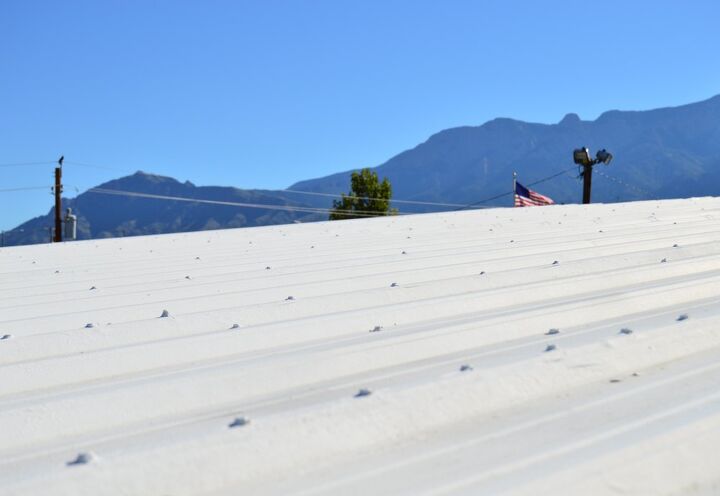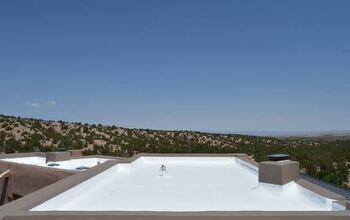Can Elastomeric Roof Coating Be Tinted?

If you’ve been looking for an elastomeric roof coating, then you’ve probably noticed that most of them are white. But what if you want the coating to match the color of your roof? You may wonder if tinting is a valid option or if it will damage the coating in some way.
It’s not recommended to tint elastomeric roof coatings after purchase, but some manufacturers offer coatings in a variety of colors. Roof coatings are not the same as paint products and react differently when color is added. Most elastomeric coatings are white because it’s the most reflective, making it ideal for cooling buildings and increasing energy efficiency.
In this article, we’ll explain what elastomeric roof coatings are and what benefits they offer. We’ll also discuss whether elastomeric roof coatings can be tinted or painted and answer other common questions regarding elastomeric coatings.
Do You Need Roofing, Siding, or Gutter Installers?
Get free, zero-commitment quotes from pro contractors near you.

What Is Elastomeric Roof Coating?
Elastomeric roof coating is usually made from silicone or acrylic, and it’s applied as a liquid. When it cures, it’s durable and highly elastic. Its elasticity is where the “elastomeric” in its name comes from.
Because of its amazing elasticity, an elastomeric roof coating is easy to apply to most surfaces. It’s also extremely adaptable to a variety of weather conditions.
You can apply elastomeric roof coatings to new roofs to give them an extra weatherproofing layer. Another option is to apply elastomeric roof coatings to older roofs. This extends their lifespan, reinforces their integrity, and seals leaks.
Benefits Of Elastomeric Roof Coating
Many benefits come with elastomeric roof coatings. One is that this type of roof coating has a cooling effect, which provides UV protection and better energy efficiency. Another is that elastomeric roof coatings give additional weathering and waterproofing protection and act as a shield against inclement weather.
Plus, elastomeric roof coatings are easy to repair and maintain. Perhaps best of all, they last ten to 20 years and extend the roof’s life expectancy.
What Is The Difference Between Elastomeric And Acrylic Paint?
There are multiple differences between these two types of paint.
Strength
One of the biggest differences between elastomeric and acrylic paint is that elastomeric paint is stronger. It’s important to note that elastomeric paint often contains acrylic, but it is thicker and lasts longer. This makes elastomeric paint a great choice for exterior surfaces.
Breathability
Another difference is that elastomeric paint is not very breathable, but acrylic is. Acrylic allows any moisture from underlying surfaces to escape, but elastomeric paint traps it.
Versatility
When it comes to interior surfaces, acrylic paint has more versatility and doesn’t require additional treatments. Meanwhile, elastomeric paint often needs epoxy when used on interior surfaces.
Affordability
Finally, acrylic paint is much more affordable than elastomeric paint. In addition, it can be used by itself, whereas elastomeric paint requires multiple layers, plus a primer and base coat. These come with additional costs.
Can You Tint Elastomeric Roof Coating?
It’s not recommended to tint elastomeric roof coating after purchasing it. This is because roof coatings are not the same as typical paint products; in fact, they are fundamentally different.
The majority of elastomeric roof coatings are white. This is because white coatings are the most reflective, and therefore the best at keeping buildings cool.
However, some manufacturers do offer elastomeric roof coatings in a variety of colors that still offer some reflective properties. Common colors include blue, red, and tan. Again, tinting elastomeric roof coating yourself after purchase is not recommended.
Can Elastomeric Roof Coating Be Painted?
Yes, you can paint over an elastomeric roof coating. A high-quality exterior acrylic latex paint can refresh the coating, but sufficient preparation is necessary.
You’ll need to remove any chalk, mildew, and dirt and address any underlying issues. This often involves sealing openings and cracks on the roof. It’s also important to check the coating for adhesion loss, such as blistering.
Always apply paint during moderate weather conditions to avoid cracking. Be sure to use paint with coats that are at least 1.5 to two millimeters thick.
Can You Paint Latex Over Elastomeric?
The best option when painting over elastomeric is premium-grade acrylic latex paint. If the surface has pinholes, then you’ll want to prime before painting using a block-filling primer. Painting over elastomeric coatings can increase their lifespan.
Do You Need To Prime Before Elastomeric?
Yes, priming before applying the elastomeric coating is extremely important. The amount of primer applied underneath the coating directly impacts its longevity and waterproofing qualities.
Some contractors use one gallon of primer for every 400 square feet. However, experts recommend using one gallon for every two square feet for the most protection.
Do You Need Roofing, Siding, or Gutter Installers?
Get free, zero-commitment quotes from pro contractors near you.

How Long Do Elastomeric Roof Coatings Last?
The average life expectancy of an elastomeric roof coating ranges from five to 20 years. The average lifespan is ten years, but some coatings can last over 20 years. It really depends on how well the coating is applied and maintained.
The biggest factor in the life expectancy of an elastomeric roof coating is the thickness of the application. A good primer is key, and then the thickness of the coating itself is highly important.
Varying Warranties
Generally, contractors offer a 10-year warranty for a coating that is 20 millimeters thick. They typically offer an 18-year warranty if the elastomeric roof coating is 30 millimeters thick. In most cases, it’s not recommended to apply the coating any thicker than 30 millimeters.
Required Maintenance
Yearly maintenance for elastomeric roof coatings consists of hosing down the roof. Homeowners can usually do this themselves. For other aspects of maintenance, though, they’ll need to find a trusted roofing contractor.
Contractors can evaluate the roof and check for damage. They can also make sure that water is flowing properly and not pooling on the roof. Inspections should be scheduled every two years or so; this helps detect issues early on before they cause significant damage.
Some homeowners wonder if it’s really necessary to maintain their elastomeric roof coatings. While it’s not necessarily required to keep up with maintenance, doing so can extend your coating’s and roof’s lifespans. Because of this, it’s generally considered worth it; maintenance saves you money long-term.

With a lifelong passion for writing plus strong enthusiasm for home improvement and DIY projects, joining the team at Upgraded Home was an easy choice. Jessica Allen likes to share helpful information with current and aspiring homeowners. Aside from writing, Jessica loves doing yoga, playing the piano, and dabbling in graphic design.
More by Jessica Allen















![Standard Dining Room Table Dimensions [for 4, 6, 8, 10 and 12 People]](https://cdn-fastly.upgradedhome.com/media/2023/07/31/9074335/standard-dining-room-table-dimensions-for-4-6-8-10-and-12-people.jpg?size=350x220)











